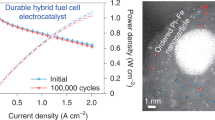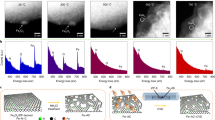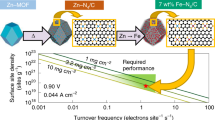Abstract
Proton-exchange-membrane fuel cells (PEMFCs) are attractive next-generation power sources for use in vehicles and other applications1, with development efforts focusing on improving the catalyst system of the fuel cell. One problem is catalyst poisoning by impurity gases such as carbon monoxide (CO), which typically comprises about one per cent of hydrogen fuel2,3,4. A possible solution is on-board hydrogen purification, which involves preferential oxidation of CO in hydrogen (PROX)3,4,5,6,7. However, this approach is challenging8,9,10,11,12,13,14,15 because the catalyst needs to be active and selective towards CO oxidation over a broad range of low temperatures so that CO is efficiently removed (to below 50 parts per million) during continuous PEMFC operation (at about 353 kelvin) and, in the case of automotive fuel cells, during frequent cold-start periods. Here we show that atomically dispersed iron hydroxide, selectively deposited on silica-supported platinum (Pt) nanoparticles, enables complete and 100 per cent selective CO removal through the PROX reaction over the broad temperature range of 198 to 380 kelvin. We find that the mass-specific activity of this system is about 30 times higher than that of more conventional catalysts consisting of Pt on iron oxide supports. In situ X-ray absorption fine-structure measurements reveal that most of the iron hydroxide exists as Fe1(OH)x clusters anchored on the Pt nanoparticles, with density functional theory calculations indicating that Fe1(OH)x–Pt single interfacial sites can readily react with CO and facilitate oxygen activation. These findings suggest that in addition to strategies that target oxide-supported precious-metal nanoparticles or isolated metal atoms, the deposition of isolated transition-metal complexes offers new ways of designing highly active metal catalysts.
This is a preview of subscription content, access via your institution
Access options
Access Nature and 54 other Nature Portfolio journals
Get Nature+, our best-value online-access subscription
$29.99 / 30 days
cancel any time
Subscribe to this journal
Receive 51 print issues and online access
$199.00 per year
only $3.90 per issue
Buy this article
- Purchase on SpringerLink
- Instant access to full article PDF
Prices may be subject to local taxes which are calculated during checkout




Similar content being viewed by others
Data availability
The data supporting the findings of the study are available within the paper and its Supplementary Information.
References
Mehta, V. & Cooper, J. S. Review and analysis of PEM fuel cell design and manufacturing. J. Power Sources 114, 32–53 (2003).
Haryanto, A., Fernando, S., Murali, N. & Adhikari, S. Current status of hydrogen production techniques by steam reforming of ethanol: a review. Energy Fuels 19, 2098–2106 (2005).
Liu, K., Wang, A. Q. & Zhang, T. Recent advances in preferential oxidation of CO reaction over platinum group metal catalysts. ACS Catal. 2, 1165–1178 (2012).
Park, E. D., Lee, D. & Lee, H. C. Recent progress in selective CO removal in a H2-rich stream. Catal. Today 139, 280–290 (2009).
Trimm, D. L. Minimisation of carbon monoxide in a hydrogen stream for fuel cell application. Appl. Catal. A 296, 1–11 (2005).
Bion, N., Epron, F., Moreno, M., Marino, F. & Duprez, D. Preferential oxidation of carbon monoxide in the presence of hydrogen (PROX) over noble metals and transition metal oxides: advantages and drawbacks. Top. Catal. 51, 76–88 (2008).
Saavedra, J. et al. Controlling activity and selectivity using water in the Au-catalysed preferential oxidation of CO in H2. Nat. Chem. 8, 584–589 (2016).
Grisel, R. J. H. & Nieuwenhuys, B. E. Selective oxidation of CO over supported Au catalysts. J. Catal. 199, 48–59 (2001).
Qiao, B. T. et al. Single-atom catalysis of CO oxidation using Pt1/FeOx. Nat. Chem. 3, 634–641 (2011).
Qiao, B. T. et al. Ferric oxide-supported Pt subnano clusters for preferential oxidation of CO in H2-rich gas at room temperature. ACS Catal. 4, 2113–2117 (2014).
Fukuoka, A., Kimura, J. I., Oshio, T., Sakamoto, Y. & Ichikawa, M. Preferential oxidation of carbon monoxide catalyzed by platinum nanoparticles in mesoporous silica. J. Am. Chem. Soc. 129, 10120–10125 (2007).
Fu, Q. et al. Interface-confined ferrous centers for catalytic oxidation. Science 328, 1141–1144 (2010).
Alayoglu, S., Nilekar, A. U., Mavrikakis, M. & Eichhorn, B. Ru–Pt core–shell nanoparticles for preferential oxidation of carbon monoxide in hydrogen. Nat. Mater. 7, 333–338 (2008).
Ko, E. Y., Park, E. D., Lee, H. C., Lee, D. & Kim, S. Supported Pt–Co catalysts for selective CO oxidation in a hydrogen-rich stream. Angew. Chem. Int. Ed. 46, 734–737 (2007).
Watanabe, M., Uchida, H., Ohkubo, K. & Igarashi, H. Hydrogen purification for fuel cells: selective oxidation of carbon monoxide on Pt–Fe/zeolite catalysts. Appl. Catal. B 46, 595–600 (2003).
George, S. M. Atomic layer deposition: an overview. Chem. Rev. 110, 111–131 (2010).
Lu, J. L. et al. Toward atomically-precise synthesis of supported bimetallic nanoparticles using atomic layer deposition. Nat. Commun. 5, 3264 (2014).
Lu, J. L., Elam, J. W. & Stair, P. C. Atomic layer deposition – sequential self-limiting surface reactions for advanced catalyst “bottom-up” synthesis. Surf. Sci. Rep. 71, 410–472 (2016).
Puurunen, R. L. Surface chemistry of atomic layer deposition: a case study for the trimethylaluminum/water process. J. Appl. Phys. 97, 121301 (2005).
Rooth, M. et al. Atomic layer deposition of iron oxide thin films and nanotubes using ferrocene and oxygen as precursors. Chem. Vap. Depos. 14, 67–70 (2008).
Scheffe, J. R. et al. Atomic layer deposition of iron(III) oxide on zirconia nanoparticles in a fluidized bed reactor using ferrocene and oxygen. Thin Solid Films 517, 1874–1879 (2009).
O’Neill, B. J. et al. Catalyst design with atomic layer deposition. ACS Catal. 5, 1804–1825 (2015).
Chen, G. X. et al. Interfacial effects in iron-nickel hydroxide–platinum nanoparticles enhance catalytic oxidation. Science 344, 495–499 (2014).
Fu, Q., Yang, F. & Bao, X. H. Interface-confined oxide nanostructures for catalytic oxidation reactions. Acc. Chem. Res. 46, 1692–1701 (2013).
Westre, T. E. et al. A multiplet analysis of Fe K-edge 1s→3d pre-edge features of iron complexes. J. Am. Chem. Soc. 119, 6297–6314 (1997).
Paul, R., Reifenberger, R. G., Fisher, T. S. & Zemlyanov, D. Y. Atomic layer deposition of FeO on Pt(111) by ferrocene adsorption and oxidation. Chem. Mater. 27, 5915–5924 (2015).
Butcher, D. R. et al. In situ oxidation study of Pt(110) and its interaction with CO. J. Am. Chem. Soc. 133, 20319–20325 (2011).
Zhai, Y. P. et al. Alkali-stabilized Pt-OHx species catalyze low-temperature water-gas shift reactions. Science 329, 1633–1636 (2010).
Yang, M. et al. Catalytically active Au-O(OH)x-species stabilized by alkali ions on zeolites and mesoporous oxides. Science 346, 1498–1501 (2014).
Acknowledgements
This work was supported by the National Natural Science Foundation of China (grants 21673215, 21533007, 21688102, 91421313, 21473169, U1632263, 11874334 and 51402283); the National Key Research and Development Program of China (grants 2017YFA0402800 and 2016YFA0200600); the Foundation for Innovative Research Groups of the National Natural Science Foundation of China (grant 11621063); the Knut and Alice Wallenberg Foundation (grant 2012.0321); the Swedish Research Council (VR; grant 2015-04062); and the One Thousand Young Talents Program under the Recruitment Program of Global Experts. The calculations were performed on the supercomputing system of the Supercomputing Center of the University of Science and Technology of China. The authors also thank the staff at the 1W1B beamline at the Beijing Synchrotron Radiation Facility (BSRF), the BL14W1 beamline at the Shanghai Synchrotron Radiation Facility (SSRF), the BL12B-a and BL10B beamlines at the National Synchrotron Radiation Laboratory (NSRL), China, and the beamline I311 at the MAX-laboratory, Sweden.
Reviewer information
Nature thanks J. Liu and the other anonymous reviewer(s) for their contribution to the peer review of this work.
Author information
Authors and Affiliations
Contributions
J.L. designed the experiments; L.C. and Q.G. did the catalytic performance evaluation; S.W., W.L., Z.S, L.C., T.Y., H.Y., H.W. and S.C. performed the XAFS measurements; R.Y. and B.W. carried out the scanning tunnelling microscopy characterization; J.W. and M.S. conducted the XPS measurements; Y.L. and C.M. carried out the scanning transmission electron microscopy measurements; Q.L., J.Y. and W.Z. performed the DFT calculations; J.L., Q.L. and S.W. co-wrote the manuscript. All the authors contributed to the overall scientific interpretation and edited the manuscript.
Corresponding authors
Ethics declarations
Competing interests
The authors declare no competing interests.
Additional information
Publisher’s note: Springer Nature remains neutral with regard to jurisdictional claims in published maps and institutional affiliations.
Supplementary information
Supplementary Information
This file contains Supplementary methods, Supplementary Figures 1-39, and Supplementary Tables 1-8
Supplementary Tables
This zipped file contains source data for Supplementary Figures 1-39 and Supplementary Tables 1-8
Rights and permissions
About this article
Cite this article
Cao, L., Liu, W., Luo, Q. et al. Atomically dispersed iron hydroxide anchored on Pt for preferential oxidation of CO in H2. Nature 565, 631–635 (2019). https://doi.org/10.1038/s41586-018-0869-5
Received:
Accepted:
Published:
Issue Date:
DOI: https://doi.org/10.1038/s41586-018-0869-5
This article is cited by
-
Designer topological-single-atom catalysts with site-specific selectivity
Nature Communications (2025)
-
Atomically intimate assembly of dual metal–oxide interfaces for tandem conversion of syngas to ethanol
Nature Nanotechnology (2025)
-
Site-specific synergy in heterogeneous single atoms for efficient oxygen evolution
Nature Communications (2025)
-
Shielding Pt/γ-Mo2N by inert nano-overlays enables stable H2 production
Nature (2025)
-
Maximizing the Pt–CuOx interface by trace Cu boosts CO preferential oxidation
Rare Metals (2025)



